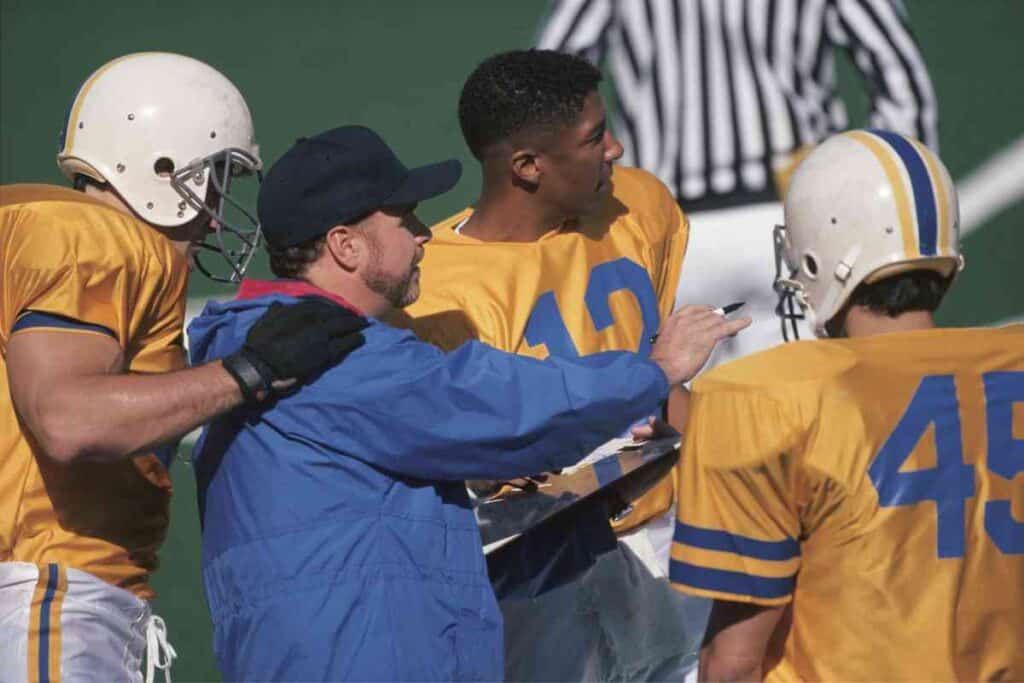How Many High School Football Players Go On To Play In College?
There are a lot more people playing football in high school than in college. How many high school football players play in college?

How Many High School Football Players Play In College?
Not many high school athletes go on to play college sports – only 1 out of 11 high school football players play college football. Division I schools are more competitive – only 1 in 40 high school athletes plays for a D1 FCS school. For D1 FBS schools, the odds are 1 in 100.
As a former college football player I understand the different divisions in college football. Even the less competitive D3 division is hard for high school players to get into.
How Many People Play High School Football?
Football is the most popular high school sport. More than a million (1,023,908) high schoolers play football. A bit less than a hundred thousand (96,368) athletes play football in college.
The odds of a high school player playing in college are only about 9.4% or 1 in 11.
The odds are different for different divisions:
- 1 in 11 plays for any college team
- 1 in 13 plays for a division 3 team
- 1 in 20 plays for a division 2 team
- 1 in 33 plays for either kind of division 1 team
- 1 in 40 plays for a division 1 FCS team
- 1 in 100 plays for a division 1 FBS team
Odds in Other Sports
Different sports have different odds. The odds of a male high school basketball player playing in college is 1 out of 17, and 1 out of 110 play for a D1 team.

Division I, II, and III Schools
The NCAA divides college sports into Division I, II, and III, or D1/D2/D3.
D1 is the most prestigious and competitive. D1 is split into FBS (the highest level) and FCS.
Each school decides what division they want their teams to play in. Usually, all of their teams have to play in the same division, so they can’t be more competitive in one sport and less competitive in another.
Division 1 FBS
Division 1 FBS (football bowl subdivision) is the highest level of college football. Players compete in large stadiums in front of huge crowds, and winning teams go on to the playoffs and a final championship.
There are 129 schools with D1 FBS teams. A high school athlete has only a 1 in 100 chance of playing D1 FBS games.

Division 1 FCS
Division 1 FCS (football championship subdivision) is still prestigious, but not as much as FBS. It is not as widely televised. FCS players have the same academic requirements as FBS players. About one in 40 high school players goes on to play FCS.
Division 2
Division 2 teams are less selective, so a high school player has a 1 in 20 chance of playing D2 football in college.
Their games are not televised, but you can still see them online. Funding is much lower than for D1 teams.
Division 3
Even making a D3 team is fairly competitive. One in 13 high school athletes goes on to play for a D3 school.
D3 schools do not offer regular athletic scholarships. However, a student can still get need-based financial assistance or an academic scholarship.
This assistance can be more generous for D3 athletes than for other students.
Television Coverage of D1/D2/D3 Games
D1 games get cable television coverage, with D1 FBS games seen on national television. D2 and D3 games are only seen online.

Stadium Size
D1 FBS stadiums are by far the biggest and have a stadium capacity of 20,000 to 115,000. D1 FCS games have a stadium capacity of 5,000 to 25,000.
D2 games have a capacity of 5000-15000, and D3 games only 2000 to 5000.
How Many High School Players Go Pro?
Only one in 554 high school football players plays in the NFL. There are over a million high school football players and only 1645 in the NFL. Not many people that try hard get to go pro.
Going Pro in Football vs Going Pro in Other Sports
The odds of a high school football player going pro are often better than for other sports. For example, a high school basketball player only has a 1 in 1920 chance of going pro.
While there are fewer high school basketball players, there are far fewer people in the NBA than in the NFL.
How Much Do Grades Matter?
Athletes need decent grades and skill at their sport to play for college teams. If a school doesn’t admit you because of your poor grades, you can’t play for that school’s team.
Academically poor students have limited schools to choose from, so they might never play college football.
Minimum Standards for Students Entering College
A high school graduate just entering college must have reasonably good grades to play college sports. They must meet two of the three criteria:
- Either a 970 on the SAT or an 18 on the ACT
- A grade point average of 2.0 in high school
- Graduating in the top of your class in high school. If your rank relative to the rest of the class is unrecorded, you can instead complete nine institutional credit hours with a grade of C or better.
College students with good grades can become eligible even if their high school grades were not good.
Scholarships for College Football Players
While many college football players get full scholarships, many others do not. A college athlete may not get a scholarship or only get a partial scholarship.
Full athletic scholarships are competitive and only for about 15% of college athletes. D1 FBS schools have 85 athletic scholarships, D2 FCS schools have 63, and D2 schools only 36.
D3 schools do not have athletic scholarships.
Recommended Reading
- How many high school football players go d1
- How Many High School Football Players Go On To Play In College?
- How many college football players make it to the NFL
- Do College Football Players REALLY Have To Attend Classes
- Why do college football players opt out of bowl games
- How many college football players are there
Key Takeaways
- A high school football player has a 1 out of 11 chance of playing in college and a 1 out of 33 chance of playing at an NCAA division 1 school.
- Division 1 FBS schools are the most competitive, so a high school player has only a 1 in 100 chance.
- Division 1 and 2 players but usually not division 3 players can get athletic scholarships.
- Only 1 in 554 high school football layers makes it to the NFL.
